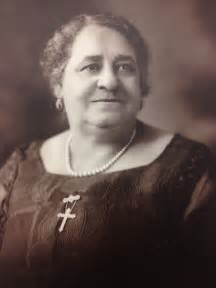
Maggie Lena Walker – First Female Bank President
For the past several months we have been relating the stories of remarkable black women in America. We began with the stories of 18thand 19thcentury African-American women. Some were born as slaves and some were born free. All of these women were courageous examples of what can be done by a woman who does not let her circumstances dictate to her. These women rose above many hardships including poverty, illness, prejudice, internal conflicts, and the limitations of their times to follow their call from God and affect the lives of many other people for good. Why were they able to live in a realm above their circumstances? It is because they all received strength from God. They all answered the call in their lives to serve.
We continued with the stories of more black women in the kingdom of God in the late nineteenth and early twentieth centuries. In spite of the limitations they had imposed on them by society these women followed their call to become evangelists, missionaries, journalists, business women, philanthropists, teachers, and activists.
Several weeks ago, we recounted the story of Madame C. J. Walker – the Firstblack woman millionaire in America! There were other “Firsts” such as Ida B. Wells, the First woman to challenge the bigotry of the transportation system by boarding a train in the ‘white’ section in 1884.[1]
For the next few weeks we will do more “Firsts”. These will include – Bessie Coleman, early pilot, daredevil and stunt flyer; Mary McLeod Bethune, educator and leader; Mae Jemison – first female black astronaut; Katherine Johnson, Dorothy Vaughan, and Mary Jackson – achievements in the space industry and instrumental in getting the first Americans in space and on the moon. Rosa Parks challenged the ‘Jim Crow’ laws in 1955 when she refused to give up her seat to a white person on a bus. These women were all very great women of courage and much to be admired.
We must include the story of Maggie Lena Walker – the First woman bank president in the United States. Maggie was also a caring Christian woman whose work enabled many black people to lead better, happier lives. She is especially remembered for her efforts for the welfare of black youth.
Maggie Lena Draper was born on July 15, 1864 in Richmond, Virginia to Elizabeth Draper, a former slave. Maggie attended the Richmond Colored Normal School, dedicated to the education of black children. In 1883 Maggie completed her training as a teacher. She took a job teaching at Lancaster School where she remained until 1886. It was while attending this school that Maggie joined the order of St. Luke.
Maggie married Armstead Walker, Jr. in 1886. At this time Maggie had to quit her job as a teacher because the school had a policy against married teachers. Maggie and Armstead had three sons; tragically baby Armstead died while still an infant. Melvin and Russell were born later. Maggie split her time between mothering her children and working for the Order of St. Luke.
In 1901 Maggie became the grand secretary of the Independent Order of St. Luke, an organization dedicated to the social and financial advancement of blacks. When Maggie joined St. Luke’s it was struggling financially. With her incredible abilities, Maggie turned it around and made it into a flourishing organization. Maggie turned the organization which was nearly bankrupt into a profitable and effective one.
Maggie made the organization a success by doing these things:
In 1902 she founded a newspaper, the St. Luke Herald to spread to the local chapters and to help with the educational work.
In 1903 she opened the St. Luke Penny Savings Bank. She remained the president until 1929. Under Maggie’s leadership the bank served a membership of over 50,000 in 1500 local chapters. Though many other banks failed during the Great Depression, Maggie kept her back alive by merging with two other banks in 1929.
In 1905 she opened the St. Luke Emporium, a department store that offered employment to black people along with a source of less expensive goods.
While doing all of this Maggie was active in social work. She took part in many educational efforts. She ran for the seat of superintendent of public instruction on the Republican ticket in 1921. She was defeated along with the other black Republican candidates. Her work for the Order of St. Luke was still ongoing with much success.
In 1925- in recognition of her efforts in the spiritual, civic, industrial and fraternal forces of the community and at large, the Virginia Union University awarded the honorary degree of Master of Science to Maggie.
For the last few years of her life, Maggie Walker was ill and confined to a wheelchair. She died from the complications of diabetes on December 15, 1934 at age 70. She is buried in Evergreen Cemetery in Richmond. In 1979 her home on East Leigh St. was purchased by the National Parks Service and became a National Historic Site.
I am so happy to put links to pictures of Maggie Lena Walker. Go to these links for her amazing story. Both productions are beautiful and interesting.
“Maggie Lena Walker”, by Marion Newton, YouTube, 11 minutes, 30 seconds.
Published on Oct 1, 2015
The First Black Woman in the United States to become a president of a local bank, Maggie’s story is told in “her voice” by a narrator. There are many great quotes. The pictures tell the story in a very memorable way. Her Christian faith became the most important thing in her life.
Another great link:
“Carry On: The Life and Legacy of Maggie Lena Walker”
[1]See post – on September 26 on this website.

